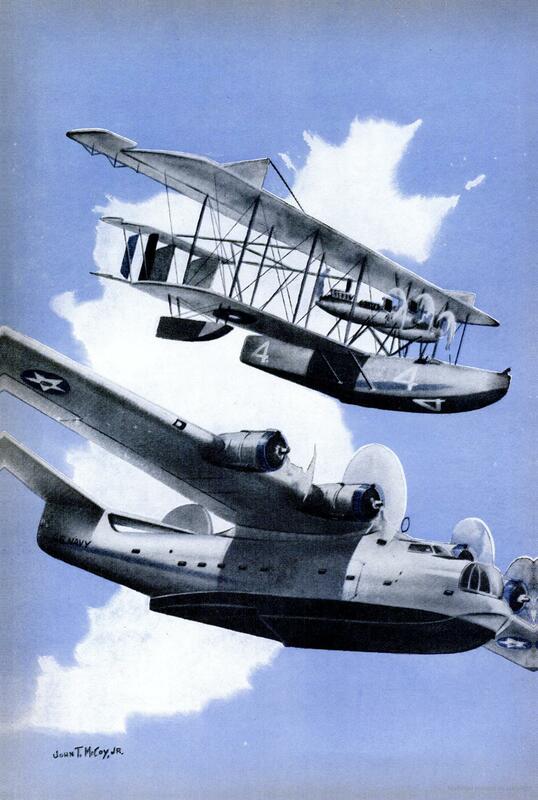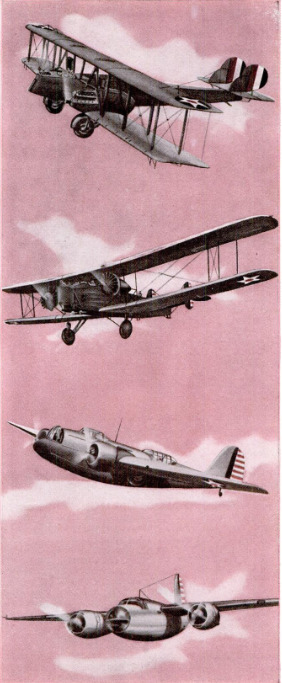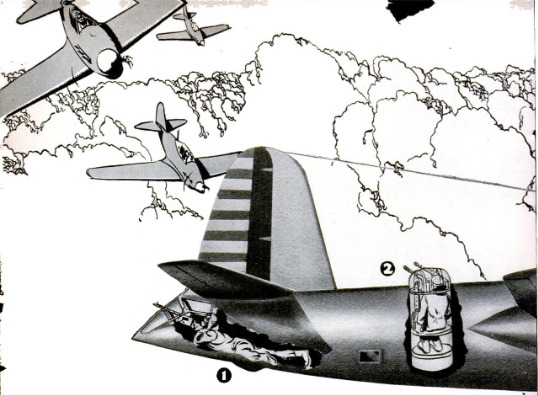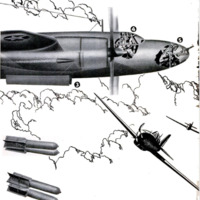-
Title (Dublin Core)
-
America's air hitting power
-
Article Title and/or Image Caption (Dublin Core)
-
Title: America's air hitting power
-
extracted text (Extract Text)
-
THIS country’s exponents of an inde-
pendent striking force of the air, co-
equal with the Army and Navy, sub-
scribe to the fighter’s traditional adage that
the most effective defense is a vigorous
offensive. Translated into terms of safe-
guarding the Western Hemisphere from
foreign attack, this means that they believe
in employing long-range bombers of the
“flying fortress” type to prevent any inva-
sion of the New World instead of attempting
to deal with it after it has occurred. Conse-
quently, they look with grave foreboding
upon a national policy—so far as the United
States can be said to have formulated one—
which ignores this principle in practice
though accepting it in theory.
Even the present world crisis, with its
brutally clear lessons on the effectiveness of
air power, has not served to clear the public
mind, or the minds of those directing our
defense program, of dangerous misconcep-
tions concerning this new form of warfare.
There is no lack of either popular or official
support (clamor might be a more descrip-
tive term) for “a strong air force.” But the
prevailing conception of this, among all but
the nation’s airmen, is, unfortunately, a
rather vague picture of swarms of airplanes
darkening the skies. It is a comforting pic-
ture to those who have it—or would be, if
only the airplanes would materialize—be-
cause they still visualize air warfare as a
battle in the air between opposing aircraft
and not as warfare waged from the air.
The heroic and spectacular performance
of the Royal Air Force in the “Battle of
Britain” probably has strengthened the
American public's misunderstanding of what
constitutes real air power. In its admiration
for the daring and courageous air fighters,
who were officially admitted to be the only
thing standing between Great Britain and
complete disaster ater Germany began her
aerial blitzkrieg, the public has almost com-
pletely lost sight of Britain's dire need of a
greater air striking force—hundreds and
thousands of bombers to blast German fly-
ing bases and hammer, far inland, at the
heart of her industrial war economy.
Too many people, some of them sitting at
our own defense councils, have been led to
forget that the British problem of coping
with air attack is totally different from that
of America, and this has added to the con-
fusion of our already muddled air-defense
thinking and planning. Merely because Spit-
fire and Hurricane pursuit planes were Eng-
land's salvation in the early days of Hitler's
“total” air war, it does not follow that
America’s safety lies in building swarms of
pursuit ships. Yet our Western Hemisphere
defense plan, as laid down by the Army's
General Staff, and approved by the Presi-
dent, called for 35 percent of all the air-
planes involved to be in the pursuit category
Champions of real air power, as applied tc
American defense needs, viewed that pro
portion as appalling. However, there is rea
son to believe that it is now being scaled
‘downward.
“The pursuit plane,” said one Army air-
man recently, “is, like the Army itself, in-
valuable for the close-in defense of our
borders, but it does not contribute one iota
to the air power of this nation. Air power
is proportional to numbers and types, not to
numbers alone. Fifty thousand pistols are
useless compared to a single rifle at a thou-
sand yards range. The pursuit plane is the
pistol of the air, while the long-range bomber
corresponds to the rifle. Why wait for your
enemy to get within pistol range, particu-
larly when you enjoy a geographical posi-
tion which makes it impossible for him to
use even his rifles against you until he does ?””
Long-range, four-engined bombers of the
“flying fortress” type, with an effective op-
erating radius of 1,000 to 1500 miles, are
the backbone of the independent air striking
force, as conceived by the proponents of a
cosrdinated land, sea, and air defense pro-
gram. They would be supplemented by
shorter-range medium bombers in some-
what larger numbers, with an operating
radius of 500 to 750 miles, and by light
attack bombers with a 250 to 375-mile
radius, as a third line of aerial offensive-
defense.
The theory of the employment of these
three types is that they would attack enemy
warships, aircraft carriers, and troop trans-
ports, three, two, and one sailing days re-
spectively, from the coastline or advanced
bases whence the bombers were operating.
It is self-evident that the nation’s “air
frontier” is extended under this system by
just so many sailing days as its air base
outposts are distant from the mainland.
One tremendous advantage enjoyed by the
flying fortresses, and shorter-range bomb-
ers now being built to supplement them in
this type of air warfare, is that they will
be faster than any carrier-borne foreign
pursuit plane, so far developed, which might
be brought into action against them at sea.
Thus, they are virtually invulnerable to air
attack so long as they succeed in their
fundamental mission of preventing enemy
air forces from reaching and establishing
themselves in New World bases. This ad-
vantage, of course, will be lost in the case of
the flying fortresses released to Great Brit-
ain, which will be exposed to swift, land-
based German pursuit ships having a sub-
stantial edge on them in speed.
In order for an aircraft carrier's planes to
attack seaboard objectives, it is necessary
for the mother ship to launch them close
enough inshore so they will have sufficient
fuel not only to carry out their mission, but
to overtake and rejoin the carrier as she
steams back out to sea. Roughly, the off
shore launching distance figures out to 300
miles. Since a carrier can cover approxi-
mately the same distance in a ten-hour
night's run, it is obvious that such a vessel
must not be more than 600 miles from her
objective by sundown of the preceding day,
assuming that her planes are to be launched
at dawn. Consequently, a thorough daylight
air patrol of the 600-mile zone insures a
one-day warning of such an attack, if not
the certain destruction or disabling of the
carrier; while a 1,200-mile patrol provides a.
two-day safeguard. In either case, of course,
bad weather and poor visibility might enable
a carrier to slip in and deliver a serious
attack.
Alir-defense tactics of this nature already
have been worked out by the General Head-
quarters Air Force of the Army, which was
created several years ago as a half-hearted
step in the direction of an independent
striking force of the air, but is still subject
to the limitations imposed upon it by a
ground command. Such tactics would be put
into as full-scale effect, in the event of war,
as the limited flying equipment now pos-
sessed by the G.H.Q. Air Force would per-
mit, and presumably would be codrdinated
with offshore patrols of the Navy's air
force.
However, the Army and Navy high com-
mands hold many divergent ideas concern-
ing the employment of aviation in warfare;
known jealousies exist between the two
services, and there is too little assurance of
the most effective air teamwork possible
between them if a real defense crisis occurs.
This should not be construed as
any slur at able and efficient offi-
cers who head both the Army
and Navy; it is simply an ap-
praisal of their unswerving de-
Votion to the traditions of their
respective services and of their
limited-horizon concept of air
power as still being in its swad-
dling-clothes role of an “auxil-
iary service” to land and sea
forces.
Accepting the fact that Amer-
ica’s air power, for the present,
is still controlled by men with-
out thorough understanding of
either its limitations or possibili-
ties, an examination of the coun-
try’s present and projected air
strength, together with plans
for its use in a real national
emergency, would seem to be in
order. At the moment, the Army
has approximately 3,000 air-
planes of all types, including
training ships and obsolete com-
bat planes; the Navy total is
about 2,500. By July 1942, under
plans approved by the National
Defense Advisory Commission,
the Army is scheduled to have
an overall total of 18,000 planes
and the Navy 7.000.
Nearly half of the Army's
proposed 18,000 airplanes will be
trainers, because the Air Corps
faces the necessity of turning
out five times the number of
pilots it started with last sum-
mer, as well as acquiring five
times the number of aircraft
then on hand. Corresponding
Navy proportions are somewhat
lower, because the Navy tradi-
tionally manages to keep abreast
of its current needs better than
the Army, with the result that
its air force is not undergoing
so extensive an expansion. The
Army's present strength in com-
bat planes totals about 1,300; of
these 1,000 are obsolete types by
our own standards, and the other
300 would be “suicide crates” in
Europe's war because they are
not yet equipped with protective
armor plate for the crews, or
self-sealing fuel tanks, and because they
lack adequate gun power.
A breakdown of the Army's strength in
combat aircraft “on hand and on order”
shows that it now has, in round numbers,
100 long-range, four-engined bombers as a
nucleus for its projected fleet of at least
1,000 such ships. In the two-engined me-
dium-bomber class, it has 350 ships of a
woefully outmoded type, and plans for 1,500
such craft of modernized design and per-
formance. In the light attack-bomber field
it now has nothing at all, but has placed
orders for 1,200 twin-engined craft of this
type. On the pursuit front, the Army could
muster some 650 obsolete ships and 200 of
modern design—barring the fact that they
have not yet been brought up to the Euro-
pean standards previously mentioned—and
expects to have a total of 2,000 to 3,000.
In the non-combat field, it is interesting to
note that the Army, profiting from lessons
learned in Europe, will procure 2,000 twin-
engined observation planes to replace pres-
ent single-engined ships of this type now
considered useless in modern air warfare.
Besides training and combat types, the
Army's plans call for some 500 transport
planes of either the four-engined or super-
twin-engined type, capable of carrying 20
soldiers each, with full arms and equip-
ment for 24 to 36 hours combat operation,
on nonstop flights of 1,500 miles. These air-
craft, however, probably won't be delivered
until 1943. What they will mean is the
ability to concentrate a highly trained land
force of 10,000 men on short notice at any
“danger zone” in the Western Hemisphere
where suitable landing fields are available.
Hence the importance of the various air
bases which the United States is now striv-
ing to acquire at strategic points through-
out the New World. Anyone with a map and
a ruler can figure out about how many such
bases are needed and where they should be
located. Nor does it require a military
master mind to see the seriousness of allow-
ing a hostile force to establish itself at such
bases within air striking distance of the
United States or its defense outposts.
-
Contributor (Dublin Core)
-
C. B. Allen (article writer)
-
Language (Dublin Core)
-
Eng
-
Date Issued (Dublin Core)
-
1941-04
-
pages (Bibliographic Ontology)
-
113-117
-
Rights (Dublin Core)
-
Public domain
-
Archived by (Dublin Core)
-
Sami Akbiyik
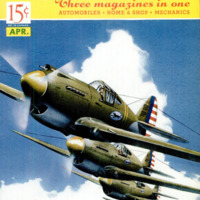 Popular Science Monthly, v. 138, n. 4, 1941
Popular Science Monthly, v. 138, n. 4, 1941

